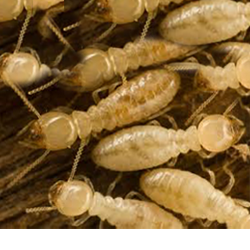
Termite Treatment Featuring Termidor HP
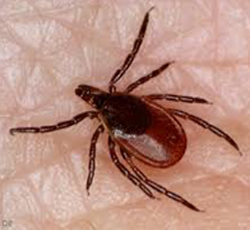
Lyme Disease Prevention
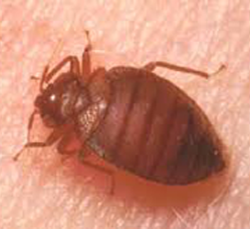
Bed Bugs

Mosquito Prevention

Odorous House Ants
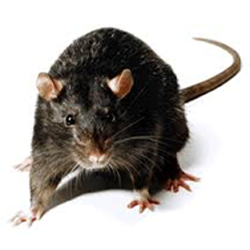
Rodents

Insects & Spiders
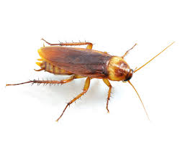
Roaches










Rabbits degrade the land mainly by eating the vegetation that is critical in maintaining soil stability. In their quest for food, wild rabbits can cause considerable damage to a vegetable garden. In winter they eat the bark and shoots of leaves and bushes, sometimes girdling the entire base of a tree and thus killing it.
Regional Pest Management has proven ways of controlling wild rabbits that may be plaguing your home, lawn, woods or garden. Call Jeff Hauf at 1-800-36-5-STAR (toll-free) or 410-737-0940 today!
'; break; case 'insects': $title = 'Insects and Spiders'; $banner = 'spiders-banner.png'; $content = '







Lyme Disease is on the rise in the U.S. Your odds of contracting the disease are directly related to the number of ticks on your property that carry the disease-causing bacteria. Lyme Disease is not an illness to be taken lightly; it can be difficult to diagnose, and if it goes undiagnosed and untreated, it can result in serious, permanent damage to the victim\'s joints and heart.
Animals can be affected too! Dogs, cats, horses are all subject to Lyme Disease.
As most people know, the deer tick is the culprit that infects people and animals with Lyme Disease. Naturally then, when most people think of the disease, they think of deer and deer ticks. Deer do serve as hosts to the deer tick, but they are passive hosts. The most important players in the spread of Lyme Disease are the white-footed mouse and chipmunk. These rodents primarily harbor the bacteria that cause Lyme Disease. Ticks pick up the bacteria when they feed on the blood of infected animals. While in the immature stages, deer ticks pass the Lyme Disease bacteria to and from the mice and chipmunks they typically feed on. During the tick\'s nymph stage, they might also feed on humans and pets.
At this point the ticks are light in color and no bigger than pinheads, so they are hard to see and can easily go undetected.
Regional currently offers two different methods for getting rid of ticks around your yard. Our all-natural mosquito treatment also kills ticks. Click here for more information about that treatment.
We also offer tick boxes that can be placed around your yard. These tick boxes help kill the immature stages of ticks when they feed on mice or chipmunks.
The Tick Control System is a small plastic box which holds an insecticide that Is effective against ticks, and a bait that is attractive to mice. The bait will attract mice living on and around your property to the system\'s boxes. As a mouse moves through a box, it will pass under a small applicator wick containing a low-dose insecticide. The wick will lightly brush its head or shoulders, gently applying traces of the insecticide. The insecticide won\'t harm the mouse or any other animal that might touch or even eat the bait, but it will kill the ticks that the mice are carrying. A single dose will protect the mice for up to 40 days against any new ticks.
Let our family protect your family! There are several ways to get rid of mosquitos around your home, but at Regional we\'ve chosen a 100% all-natural solution.
We are typically all for killing bugs, but as a company, we have decided to go with an all-natural solution so we can protect bees. Bees are a very important part of our eco system and should only be killed or removed when they pose a threat to us. Although some pesticides labeled for mosquitos claim they are "all natural," they can still kill bees.
Our solution is garlic based, so it is safe for your family, pets, and bees! Since mosquitoes are soft-bodied insects, the garlic juice can be very toxic to them in increased concentrations. The odor of garlic chases them away for as long as they can detect the odor. The odor of sprayed garlic juice becomes undetectable to humans within minutes, but mosquitoes can detect odor as much as 10,000 times better than a human. So even though you can\'t smell the garlic, they can and they will stay away from the sprayed area!
Depending on the environment around your home, we can also use larvicides. Larvicides are products used to help control mosquitos outside of your home. They work by killing young mosquitos before they can grow into biting adults. They do not harm people, pets, or the environment when professionally used.
Contact us today to get our expertise on getting rid of your mosquitos!
'; break; case 'spiders': $title = 'Spiders'; $banner = 'spiders-banner.png'; $content = 'Few creatures are as feared and misunderstood as spiders. For the most part, spiders are harmless and generally beneficial to us, by keeping insect populations in check. Spiders are seldom aggressive and bite only when threatened or injured. Few spiders bite people, and the venom of most is harmless.
However, the bite of the black widow and the brown recluse spider (also known as the Recluse or Fiddle Back) can be quite dangerous.
Beneficial or not, if spiders indoors or outdoors become a pest, you need to call Regional Pest Management at 1-800-36-5-STAR to bring them under control. The better you understand any pest, the easier it will be to eliminate or control - and Regional Pest Management understands spiders!
Spiders are the largest group of arachnids. There are more than 35,000 named species worldwide, including about 3,000 in North America. These predators live almost everywhere - on the ground, under rocks, inside and underneath playground equipment, among grasses, on plants, in tree branches, in underground caves and even on the water. Spiders frequently stray into dwellings, or may be accidentally introduced on firewood, laundry that has been hung out to dry, and on flowers. In windows and near outdoor lighting, web-building spiders often construct webs because insect prey may be attracted at night by the lights and by air currents.
Spiders are abundant (over 1,000,000 individuals per acre in a grassy field) and can be found almost anywhere from the bedroom closet to the 22,000 foot level on Mt. Everest. There are about 2,500 different species in North America. Some live in holes in the ground while others may be found under rocks or logs. Those that prefer dark, shaded areas may also be found in cellars and basements. As we mentioned above, most spiders found in homes and buildings are "accidental invaders"; however, homes in wooded areas or with naturalized or landscaped foundations may be prone to more frequent invasion because the surroundings are ideal spider habitats.
Virtually all spiders have poison glands that connect with the fangs. Venom produced by the glands apparently is used to kill or paralyze prey and in defense. Most species do not attempt to bite humans; many have fangs that are not capable of piercing human skin. However, some will, with results that are similar to a wasp or bee sting. There is always the chance that a person can have an allergic reaction to the venom.
Please select these links for specific information and pictures of spiders:
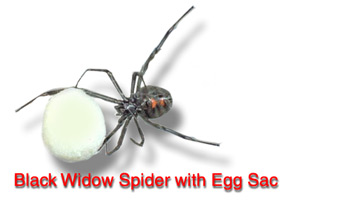 ';
break;
case 'blackwidow':
$title = 'Black Widow Spiders';
$banner = 'spiders-banner.png';
$content = '
';
break;
case 'blackwidow':
$title = 'Black Widow Spiders';
$banner = 'spiders-banner.png';
$content = '
Araneae: Theridiidae, Latrodectus mactans
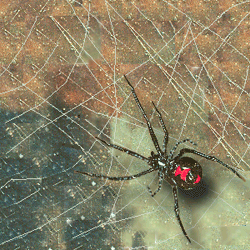
The bite of the female black widow spider may not always be felt at first and besides slight local swelling, there is usually little evidence of a lesion. Two tiny red spots can sometimes be observed in the center of the swollen area. Most of the time, pain at the site of the bite occurs immediately and becomes most intense after about three hours. An overall aching of the body, especially in the legs, is a common reaction. Headache, elevated blood pressure, nausea and profuse perspiration may occur in severe cases. The condition is self-limiting and in most cases symptoms disappear in two or three days. Calcium gluconate is used intravenously to relieve and relax muscle spasms produced by black widow venom.
Be very careful when working around areas where black widow spiders may be established. Take proper precautions, wear gloves and pay attention to where you are working. Black widow bites are sharp and painful, and the victim should go to the doctor immediately for treatment. For more about control of the black widow spider, please call Regional Pest Management today at 1-800-36-5-STAR.
'; break; case 'recluse': $title = 'Brown Recluse Spiders'; $banner = 'spiders-banner.png'; $content = 'Araneae: Loxascelidae, Loxosceles reclusa
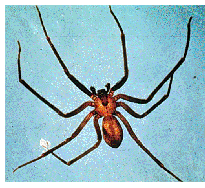
Brown recluse spiders belong to a group of spiders commonly known as violin spiders or fiddle backs. This is because of a characteristic fiddle-shaped pattern they have on their head region. The spider is golden brown with the fiddle being dark brown or black. This spider is not hairy and the fiddle pattern is often shiny. They are about 1/4 to 3/4 inch long.
Members of this small family are known for their poisonous venom. They have six eyes in three pairs. The cephalothorax is rather flat above and has a conspicuous, lengthwise furrow in the midline at the rear third. Each foot has two claws. Many wolf spiders are similar in appearance and have similar markings as the brown recluse. However, wolf spiders are large, robust, hairy, and therefore they can be distinguished from the brown recluse.
Brown recluse spiders spin small, irregular webs under bark, stones or other secluded areas. Their venom is especially poisonous to people; those bitten often become ill and find that the wound does not heal quickly. Both male and female recluse spiders, as well as their spiderlings, are capable of injecting venom which may result in serious lesion formation or systemic reactions. The severity of the bite may vary. The symptoms may vary from no harm at all to a reaction that is quite severe. Usually, the brown recluse spider bite is not felt and the pain sets in from six to eight hours later. A typical bite area may resemble a pimple, postule or blister formation within six to 12 hours later. Mild to severe pain accompanied by swelling may occur during this interval. The surrounding tissue begins to darken, is irregular in shape with sharply raised edges resulting in a sunken area which may be several centimeters in diameter. Often there is a systemic reaction within 24-36 hours characterized by restlessness, fever, chills, nausea, weakness, and joint pain. Where the bite occurs there is often tissue death and skin is sloughed off. In some severe cases, a wound may develop that lasts several months. In all cases, a physician should be notified. If at all possible, kill and take the spider to the physician for positive identification. Individual spiders can be crushed underfoot or sprayed with an aerosol spray.
Brown recluse spiders are found primarily in the Midwest. Many cases of bites are reported from Alabama, Florida, Georgia, Texas, Kansas, Missouri, and Oklahoma. They are suspected of being in other states as well. The edge of its range just reaches the tip of western Virginia. The spider commonly lives in basements, attics and garages of houses and often hides behind boards and boxes. Bites often occur when the spiders hide in towels or old clothes left in those areas. The brown recluse has adapted quite well to indoor habitats. They are commonly found in the storage areas of residences, including areas such as attics, closets, bedrooms and other dark recesses. This spider frequently inhabits clothing, toys, books, boxes, furniture as well as transport trucks, tool sheds, tree houses and little used or abandoned dog houses.
Brown recluse spiders are nocturnal and prefer foods such as firebrats, crickets, cockroaches and other soft bodied creatures. Earning their name well, the recluse spider ceases its wanderings at first light. People are most commonly bitten in bed, while changing clothes, or cleaning storage areas. Not only will this spider hide in cracks and crevices of the home, they will also often climb into clothing or shoes that someone has laid out to wear the following day.
The female brown recluse spider deposits eggs in off-white silken cases about one-third inch in diameter in sheltered, dark areas. Spiderlings emerge in 24-36 days and abandon the egg case. Development is slow, influenced by weather conditions and food availability. They reach maturity in 10 to 12 months and can survive long periods of time without food or water. Immature spiderlings resemble adult brown recluse spiders but have lighter coloration. Adult males and females will vary from light tan to dark brown.
For methods to eliminate and control brown recluse spiders, please call Regional Pest Management today at 1-800-36-5-STAR.
'; break; case 'wolf': $title = 'Wolf Spiders'; $banner = 'spiders-banner.png'; $content = '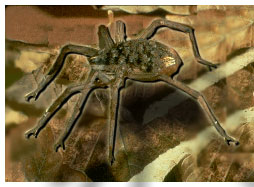
Wolf Spiders or ground spiders are common. Most are dark brown. Wolf spiders actively hunt prey and do not use snares or webs. They inhabit grassy or leaf-covered areas and may be active during the day or at night. The female carries an egg sac on her rear end and the young ride on her back for a time after hatch.
They look fierce and their rapid movements make them seem aggressive. They have strong fangs and could bite if disturbed or pinched. Wolf spiders do not persist indoors but are common "accidental invaders."
For more about control of wolf spiders, please call Regional Pest Management today at 1-800-36-5-STAR.
'; break; case 'spidersother': $title = 'Other Spider Types'; $banner = 'spiders-banner.png'; $content = 'There are many other types of spiders all around us; in fact, it has been estimated that you are never more than 4 feet from a spider, indoors or outdoors! If you are having spider problems, call Regional Pest Management today at 1-800-5-STAR to arrange a thorough treatment.
Dolomedes is a genus of spiders of the family Pisauridae. They are also known as fishing spiders or dock spiders. Almost all Dolomedes species are semi-aquatic, with the exception of the tree-dwelling D. albineus in the southwestern United States and the grassland spider D. minor in New Zealand.
They capture prey by grappling with them using their foremost legs, which are tipped with small claws, and then injecting venom when they bite. Like all pisaurids, female Dolomedes carry their egg sacs in their chelicerae, and use silk to build a nursery web. These nursery webs are built shortly before the spiderlings emerge from the eggsac. The female places the egg sac in the nursery web, and the spiderlings emerge within twenty-four hours. The spiderlings of most North American Dolomedes species remain in the web for one week, and then disperse en masse.
D. triton, the six-spotted fishing spider, lives primarily in small lakes and ponds. This spider consumes mostly water striders, but like all Dolomedes, is an opportunistic ambush hunter that will eat anything that it can capture.
Other Dolomedes species include D. scriptus, the dark fishing spider (D. tenebrosus), the raft spider (D. fimbriatus) and the great raft spider D. plantarius.
The jumping spider family (Salticidae) contains more than 500 described genera and over 5,000 species, making it the largest family of spiders with about 13% of all species. Jumping spiders have good vision and use it for hunting and navigating. They are capable of jumping from place to place, secured by a silk tether. Both their book lungs and the tracheal system are well-developed, as they depend on both systems (bimodal breathing).
Jumping spiders are generally recognized by their eye pattern. They typically have eight eyes arranged in two or three rows. The front, and most distinctive row is enlarged and forward facing to enable stereoscopic vision. The others are situated back on the cephalothorax.
Colors and patterns vary widely. Several species of jumping spiders appear to mimic ants, beetles, or pseudoscorpions. Others may appear to be parts of grass stems, bumps on twigs, bark, part of a rock or even part of a sand surface.
Jumping spiders are generally diurnal, active hunters. Their well developed internal hydraulic system extends their limbs by altering the pressure of body fluid (blood) within them. This enables the spiders to jump without having large muscular legs like a grasshopper. The jumping spider can therefore jump twenty to sixty or even seventy-five to eighty times the length of their body. When a jumping spider is moving from place to place, and especially just before it jumps, it tethers a filament of silk to whatever it is standing on. Should it fall for one reason or another, it climbs back up the silk tether.
Unlike almost all other spiders, they can quite easily climb on glass. Minute hairs and claws on their feet enable them to grip imperfections in the glass. Jumping spiders also use their silk to weave small tent-like dwellings where females can protect their eggs, and which also serve as a shelter while moulting.
Jumping spiders are known for their curiosity. If approached by a human hand, instead of scuttling away to safety as most spiders do, the jumping spider will usually leap and turn to face the hand. Further approach may result in the spider jumping backwards while still eyeing the hand. The tiny creature will even raise its forelimbs and "hold its ground." Because of this contrast to other arachnids, the jumping spider is regarded as inquisitive as it is seemingly interested in whatever approaches it.
Crab spiders make up the Thomisidae family of the Araneae order. They are called crab spiders because they resemble crabs, with two front pairs of legs angled outward and bodies that are flattened and often angular. Also, like crabs, Thomisidae can move sideways or backward.
Crab spiders do not build webs to trap prey, but are hunters and ambushers. Some species sit on or among flowers, bark, fruit or leaves where they grab visiting insects. Individuals of some species, such as Misumena vatia, are able to change color between white and yellow to match the flower on which they\'re sitting. Other species, with their flattened bodies, hunt in the crevices of tree trunks or under loose bark. Members of the genus Xysticus hunt in the leaf litter on the ground. In each case, crab spiders use their powerful front legs to grab and hold onto prey while paralyzing it with a venomous bite.
The spiders of Thomisidae are not known to be harmful to humans. However, spiders of an unrelated genus, Sicarius, which are sometimes referred to as "crab spiders," are close cousins to the recluse spiders, and are highly venomous. The unrelated species Gasteracantha cancriformis is also commonly called the "crab spider."
The yellow (golden) sac spiders, genus Cheiracanthium, are members of the spider family Clubionidae (sac spiders): Members of this family build a sack-like, silken tube in foliage or under bark or stones as their lair. In nature Cheiracanthium species are usually found in foliage, but some species are found inside houses and around other human developments. These spiders are relatively small (10 mm body length), and are yellowish in color; they are difficult to distinguish from one another, and species identification requires examination by an arachnologist.
Yellow sac spiders are among the least known clinically significant spiders, but they are indeed capable of causing a painful bite with development of a necrotic lesion (not as severe as the brown recluse or hobo), and can sometimes produce systemic effects as well. They are very prone to bite defensively (more so than any other significantly venomous U.S. spider), and some bites in humans have occurred in unusual places, such as in automobiles and swimming pools. It is likely that many U.S. cases of necrotic arachnidism ascribed to the brown recluse spider outside of its natural range, are actually yellow sac spider bites.
Yellow sac spiders which have been implicted in human poisonings include C. inclusum in the United States and southwestern Canada, C. mildei in the United States, C. mordax in some parts of the United States and C. punctorium in Europe. In the United States inclusum (indigenous) and mildei (introduced) are the species most likely to be found, and the most likely to produce bites: These two spiders have a wide distribution in the United States, and precise ranges for them have not been defined. They tend to be transported easily, particularly in agricultural products such as grapes; in some areas it appears that grocery store grapes shipped from vineyards in California are a principal means of introduction.
Cheiracanthium mildei was first identified as a cause of necrotic arachnidism in 1970, when it was linked with skin lesions in the Boston, Massachusetts area (where it is the most common spider found in houses); it is also common in houses in New York City, and may well be the cause of recent "brown recluse bite" rumors circulating there. In the late 1970\'s and early 1980\'s mildei produced a significant number of bites in the Provo, Utah area. C. inclusum has been reported responsible for bites in Georgia and southwestern Canada; bites by this species are probably far more common and widespread than this however, and it is likely that more reports will surface as Cheiracanthium species become better known as clinically significant spiders.
Bites by yellow sac spiders generally produce instant, intense stinging pain, not unlike that of the sting of a wasp or hornet. This may be followed by localized redness, swelling and itching; these manifestations may or may not evolve into a necrotic lesion, but when that occurs healing is usually complete within eight weeks. Systemic effects are usually not severe, but when they occur may include chills, fever, headache, dizziness, nausea, anorexia, and sometimes shock. Treament for the local lesion should follow the same protocols as outlined for the hobo and brown recluse spiders: Likewise, corticosteroid therapy may be beneficial when systemic effects are present.
Cellar spiders (Pholcus phalangioides) live only in the safety of human homes: attics, cellars, garages and messy rooms where they can hang upside down in webs. Cellar spiders have gray-brown bodies that are about half an inch long. They have very long, skinny legs. Many times, cellar spiders are confused with Daddy Longlegs. Daddy Longlegs are really not spiders. Their bodies are oval shaped. A true spider\'s body has two parts.
Cellar spiders do not hurt people, but like all spiders, they are predators and carnivores. They will eat almost any kind of insect or bug. They will eat moths, mosquitoes, flies, or beetles that accidentally walk into the spider\'s web. The cellar spider will wrap an insect in a lot of spider silk and suck the bug dry. When the spider is finished, it will cut the insects loose, letting them fall to the ground making a pile of dead, dry, bug bodies.
Cellar spiders are good at finding secret places to live in. These spiders are not like most spiders who like to live alone. The cellar spider likes to live close to its mate. Male and female will often live next door to each other. The female will wrap her eggs in a see-through sack that she keeps in her mouth for safety. The babies will hatch after several weeks.
Enemies of the cellar spider are birds, wasps and people. Cellar spiders like to spin spider silk. The spider\'s legs are so thin that people can hardly tell the difference between the legs and the web. Cellar spiders will twist their bodies back and forth so fast that their bodies become blurred. This makes them hard to see. If they accidentally fall from the web, they run in a wobbly fashion, like a drunk, so that they cannot be seen easily.
The orb-weaver spiders (family Araneidae) are the builders of spiral wheel-shaped webs often found in gardens, fields and forests. Their common name is taken from the round shape of this typical web. Orb-weavers have eight similar eyes, legs hairy or spiny and no stridulating organs. The family is cosmopolitan, including many well-known large or brightly colored garden spiders. There are more than 2,800 species in over 160 genera worldwide, making this the third largest family of spiders known (behind Salticidae and Linyphiidae).
Generally, orb-weaving spiders are three-clawed builders of flat webs with sticky spiral capture silk. The building of a web is an engineering feat, begun when the spider floats a line on the wind to another surface. The spider secures the line and then drops another line from the center, making a "Y". The rest of the scaffolding follows with many radii of non-sticky silk being constructed before a final spiral of sticky capture silk. The third claw is used to walk on the non-sticky part of the web. Characteristically, the prey insect that blunders into the sticky lines is stunned by a quick bite and then wrapped in silk. If the prey is a venomous insect, such as a wasp, wrapping may precede biting.
Some "orb-weavers" do not build webs at all. Members of the genera Mastophora in the Americas, Cladomelea in Africa and Ordgarius in Australia produce sticky globules, which contain a pheromone analog. The globule is hung from a silken thread dangled by the spider from its front legs. The pheromone analog attracts male moths of only a few species. These get stuck on the globule and are reeled in to be eaten. Interestingly, both types of bolas spiders are highly camouflaged and difficult to locate.
The spiny orb-weaving spiders in the genera Gasteracantha and Micrathena look like plant seeds or thorns hanging in their orb-webs. Some species of Gasteracantha have very long horn-like spines protruding from their abdomens.
One feature of the webs of some orb-weavers is the stabilimentum, a crisscross band of silk through the center of the web. It is found in a number of genera, but Argiope, which includes the common garden spider of Europe as well as the yellow and banded garden spiders of North America, is a prime example. The band has been hypothesized to be a lure for prey, a marker to warn birds away from the web and a camouflage for the spider when it sits in the center of the web.
Most arachnid webs are vertical and the spiders usually hang with their head downward. A few webs, such as those of orb-weaver in the genus Metepiera have the orb hidden within a tangled space of web. Some Metepiera are semi-social and live in communal webs. In Mexico such communal webs have been cut out of trees or bushes and used for living fly paper.
Cobweb spider (Steatoda triangulosa) webs appear messy and disorganized, unlike the organized, circular webs made by orb-weavers and many other web-building spiders. In addition, cobweb spiders often have abdomens that are comparatively larger and more spherical than orb-weavers. Cobweb spiders have 8 eyes and (like all spiders), they have 8 legs, 2 body parts, and fang-like mouthparts called chelicerae.
Cobweb spiders undergo simple metamorphosis: like all spiders, young cobweb spiders hatch from eggs and look like tiny adults. They shed their skin as they grow. Most cobweb spiders live for less than 1 year. At the end of the summer, female cobweb spiders produce a large amount of eggs that they wrap in an egg sac made of silk. spiderlings hatch in the spring.
Cobweb spiders are common in North America, and can be found almost anywhere that they can find weeds, fences, trees, walls, or other upright structures to build their webs. Cobweb spiders are predators, and they will eat almost anything that is small enough to get trapped in their webs. Like most web-building spiders, cobweb spiders tend to have poor vision - they don\'t need to see very well because they can "feel" prey when it gets caught in their webs. Most cobweb spiders are considered beneficial to humans. They eat flies, mosquitoes, and other creatures. However, The black widow spider is a cobweb spider, and its bite can be dangerous.
'; break; case 'roaches': $title = 'Roaches'; $banner = 'home-service.png'; $content = '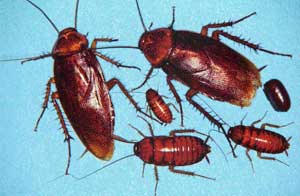
Cockroaches are among the most hated insects. Their presence in the home is offensive and implies uncleanliness. Cockroaches contaminate food and leave an unpleasant odor. They also can transmit diseases.
Most cockroaches are tropical or sub-tropical in origin and generally live outdoors.However, some species do live indoors. It is true that they thrive in dirt, trash and grime, but cockroaches can infest even clean and well-organized homes and buildings. Depending on species, cockroaches can be golden-brown, reddish-brown, lightbrown, glossy or very darkbrown, or black in color, and range from 1/2-inch to 1 3/4-inches long.
Cockroaches get into buildings in infested boxes, grocery bags, beverage cartons, furniture and dried pet foods. They also enter around loose-fitting doors and windows, where electrical lines or water and steam pipes pass through walls, through sewer lines or on seasoned firewood.
Most cockroaches come out only at night but may appear during the day when disturbed or where there is a heavy infestation. They prefer warm, dark, humid shelters like the kitchen sink or drain board; cracks around cabinets; window or door frames; loose baseboards or molding strips; upholstered furniture; bathrooms; and motor compartments of refrigerators, washing machines and other appliances. Know where cockroaches hide because these are the locations you must treat.
Cockroaches eat different plant and animal products, including meat and grease, starchy foods, sweets, baked goods and other unprotected kitchen goods. They also feed on materials such as leather, book binding and sizing, and wallpaper paste.
Use preventive measures to control cockroaches successfully. It is easier to prevent a cockroach invasion than to control an established one. Preventive measures require care, planning and continued effort to be successful. A clean home reduces the chance of cockroach infestations and the need for pesticides, but will not always prevent invasions from outside sources.
Good sanitation, both indoors and outdoors, effectively limits cockroach populations. Do not leave unwashed dishes, kitchen utensils and uncovered food out overnight. Clean up all spilled liquids. Clean areas beneath cabinets, furniture, sinks, stoves and storage bins where tiny particles of food may accumulate. Keep kitchen garbage and excess trash in container sand remove them regularly. Store dry pet food away from the kitchen and other foods. If you feed pets indoors, remove the leftover foods immediately. Clean outdoor garbage cans frequently, along with platforms or slabs on which they are kept.
Inspect regularly and thoroughly to locate conditions which invite cockroach invasions. Examine all known or suspected cockroach hiding places and incoming materials.
Seal any cracks of 1/8 inch or more in the foundation and exterior walls. Check the caulking around air conditioning units, windows, doors, pipes or other openings into the home. Repair cracks and holes in floors, walls and ceilings. Seal openings around plumbing fixtures, furnace flues, electrical outlets, windowsills and walls, and along baseboards and ceiling moldings. Repair leaky water faucets and pipes.
Keep yard trash and stacks of firewood away from your home or garage to minimize the chance of cockroach invasion. Paper, cardboard, lumber and firewood in the home provide excellent refuge for cockroaches
Trapping can reveal the hiding places and the seriousness of the infestation. Trapping alone will not eliminate cockroaches, but should be used with preventive measures for better results. Many inexpensive cockroach traps are available. They are easy to use, disposable and contain no toxic insecticide. Most are box shaped and coated with a very sticky adhesive inside. Some traps may also feature slow release food attractant. Cockroaches enter the trap when detecting the food odor and stick to the adhesive.Place traps where cockroaches are likely to travel. Change the trap\'s position if no cockroaches are caught after two or three nights.The number of traps required will depend on the kind of cockroach present and location of the infestation.
To control cockroaches with insecticides, find their daytime hiding place and thoroughly treat those areas. Regardless of the insecticide chosen, chemicals placed in or near regular hiding places provide much better control than those placed where cockroaches move only occasionally. Since some cockroach species invade homes and buildings from outside, they may reinfest dwellings once the insecticide dissipates. To solve this problem, outdoor populations must also be controlled. The type of chemical selected and the application method used depend on the location and nature of the infestation. No one chemical handles all cockroach problems, but a combination of various types is effective.
If severe or difficult cockroach infestation occur, or if you are in doubt as to proper control measures, call Jeff Hauf at Regional Pest Management: 1-800-36-5-STAR (toll-free) or 410-737-0940. Jeff and his team of professionals have the necessary equipment and training to do a safe and effective job.
'; break; case 'bees': $title = 'Bees and Wasps'; $banner = 'home-service.png'; $content = '